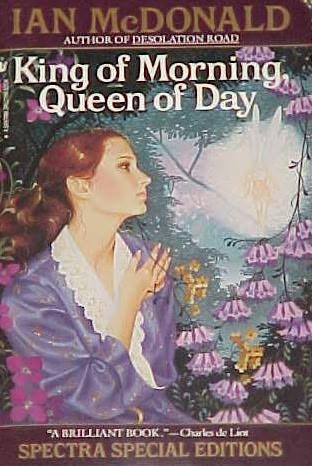King of Morning, Queen of Day was first published in 1991, and it won the Philip K. Dick award for best novel first published in paperback. Its French translation has just won the prestigious Prix Imaginales for best translated novel. I’ve been reading Ian McDonald from his first novel, Desolation Road. Desolation Road is kind of magic-realist SF. Everything else he’s written is firmly in the SF camp. In recent years he’s written the brilliant River of Gods and Brasyl. King of Morning, Queen of Day is, however, definitely fantasy. And it’s urban fantasy too, it’s set in modern Ireland between 1913 and 1990, and is about five generations of a family who have a propensity to “mythoconsciousness,” bringing archetypal mythic creatures into reality. It wasn’t part of the current wave of urban fantasy, and it would sit a little oddly with it. I don’t know if it was an influence or a precursor to it—it’s hard to think of it as influential when it seems as if only six people have read it and they’re all friends of mine, but maybe it was a stealth influence, a zeitgeist influence. Certainly this is a magical secret history, set in our world but with magical things going on below the surface.
The book falls into three distinct parts. The first section is set in 1913, in the Desmond family home of Craigdarragh. This part of the story is told in the form of diary entries, letters and newspaper clippings. Teenager Emily Desmond sees and photographs fairies while at the same time her father is convinced that aliens are approaching riding a comet. There’s all the background of 1913 Ireland, Yeats, paranormal investigators, the stirrings of independence, Freudian psychology, and a sepia photograph of Emily’s mother a generation earlier marked “Caroly, Wood nymph.” Emily is raped and disappears into the Otherworld, where anything she imagines can become real. Her daughter Jessica is adopted, and the second part of the novel is from her point of view as she comes into her power in the thirties in Dublin, in an independent Ireland that has developed some new history and some new mythology within her lifetime. The third part concerns her grand-daughter Enye in 1989 and 1990. As the book goes on the women at its heart get older and have more agency—Emily is a confused adolescent, and Enye is an ass-kicking bicycle courier with a katana.
What the book’s really about is the need to make new myths, dream new dreams, to have a new future. Astonishingly, it does this in Ireland, a country full of old myths, and it uses those old myths to wonderful effect. This is a book that could only have been written by someone steeped in the culture and the country and the folk-mythology. McDonald has always been brilliant on sense of place—there’s a description here of Liverpool as a foreign city that’s one of the most beautiful things I’ve ever read. He makes the place and time entirely alive and three-dimensional. This is mythologically significant Ireland, but it is deeply rooted in the real changing growing country and the real Twentieth Century. This is Ireland as a modern country—well, up to twenty years ago when the book was written—not some vague-edged emerald isle but an actual European country with specific political and magical problems. In The Voyage of the Dawn Treader there’s a mention of the island where dreams come true, and then it’s added “Not daydreams, dreams.” This is a story about the dreams of the real Ireland, and they’re not pretty, even though they’re always beautifully written.
The obvious comparison has always been to Holstock’s Mythago Wood. I am already on record as saying that King of Morning, Queen of Day makes Mythago Wood look like Winnie the Pooh, so I guess I can say it again. Mythago Wood is terribly English and coy about its avatars and archetypes, while King of Morning, Queen of Day goes head on at them. Like later works of urban fantasy, McDonald isn’t afraid of dealing with sexuality, and I think it’s sigificant that while Holdstock writes about middle-aged men lured by a romantic fantasy of woman, McDonald writes realistically about girls and sexuality and power.
While I generally find McDonald’s prose gorgeous, I don’t much like his terms for the magic here, “mytho-consciousness,” “mygmus,” “phagus”—but I do like “mythlines,” which are the way the mythic landscape overlies the geographical one. The middle part of the book has two tramps, Tiresias and Gonzago (themselves phaguses, or dreams made solid), wandering Ireland and discoursing like something out of Beckett, keeping the mythlines quiet with charged objects—cigarette packets, bottle tops, old pennies.
I’m glad the French appreciated this novel and reminded me to pick it up again.










